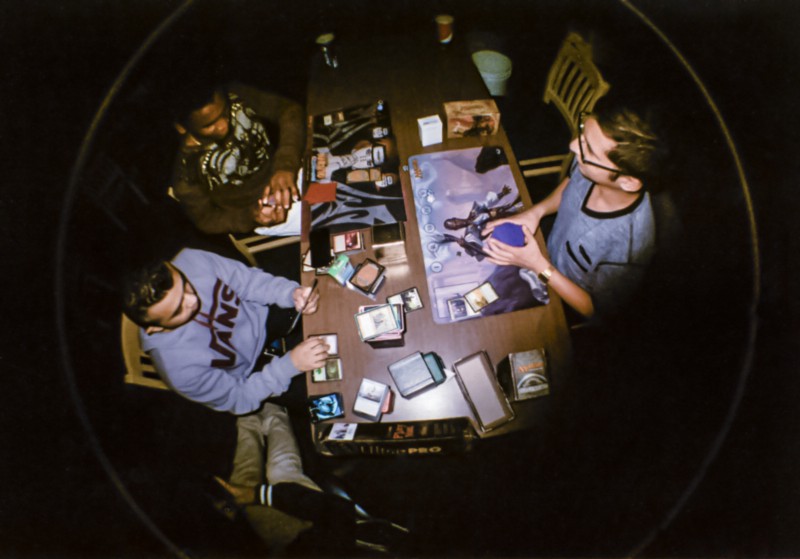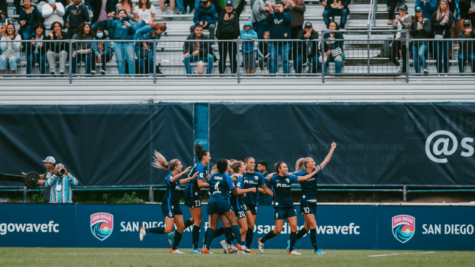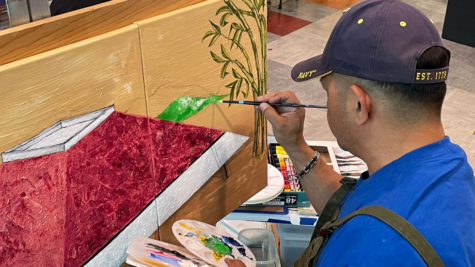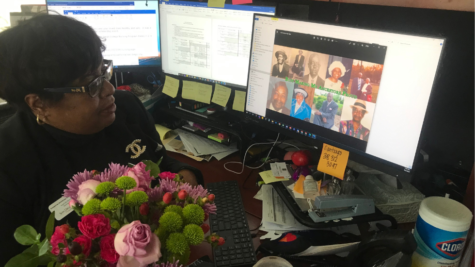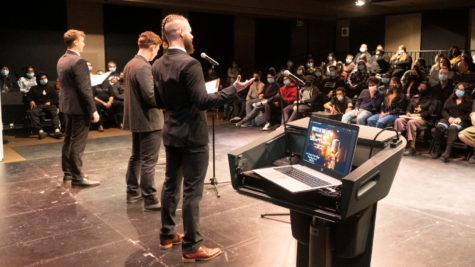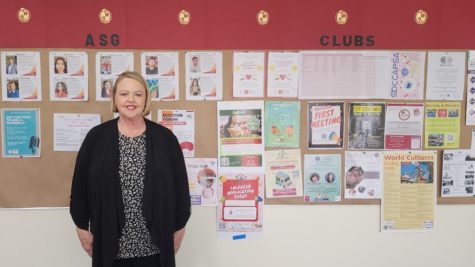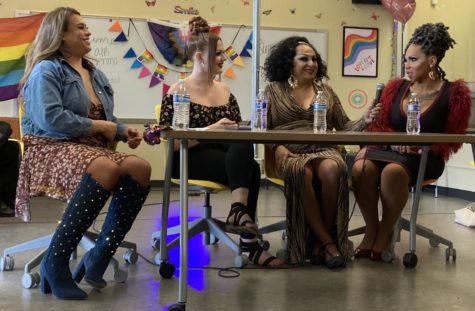Look for Some Magic in the Cafeteria
City College Student Gamers Gather Daily as Part of a Community
San Diego City College students gather for a round of games in the cafeteria in late November. (Photo by Dane Allen)
December 12, 2014
In the college cafeteria’s northeastern corner, players, spectators, and their companions lean over a table, much like knights in King Arthur’s court around a holy grail, the game board. The waxy plastic surface of the table is littered with half-drunk soda cans, tall paper soft drink cups, and triangular cardboard pizza boxes. Stacked decks of cards covered in brightly colored protective sleeves span every inch of unused surface. The board sits in the center, drawing everyone’s attention like generals examining a war map. The game is Magic the Gathering, and these head-to-head battles are the reason the cafeteria gamers have permanently commandeered this table.
Marvin, a regular to the table, and one of the players currently hunched over the game board, answers when I ask if the game is played daily. “Yeah, pretty much. There will be games going on at least once a day.” While I sat and observed, this became obvious as a shifting cast of characters participated in what seems like a never-ending round of musical chairs.
Silence at the table is as rare as some of the cards they collect. Constant chatter echoes through the cafeteria. Brief explosions of laughter are audible clear from the other side of the hall and the gamers are constantly raising their voices to be heard over one another. Though the banter is lighthearted, the guys berate each other without mercy. Thomas, another player and formidable opponent, doesn’t hesitate to correct Marvin sternly when he feels his answers to my questions aren’t accurate to the letter of the law.
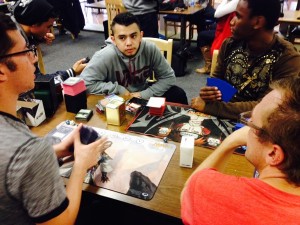
One common misconception people have about Magic the Gathering and other fantasy games is that they primarily appeal to a white audience. This couldn’t be further from the truth at City College. On a recent day, African-American, Latino, mixed-race and white students crowded the table. Another common misconception is that males predominately play this game. While this tends to be true, female participation appears to be on the rise.
“It’s male dominated in the sense that … yes, mostly guys play, but girls play too,” Marvin says.
The game appeals to a much wider population than one might think. Incidentally, there was even a student watching who no longer attends City College but was visiting on his way home from work because he’s passionate about the game and feels a sense of community here. This was more common than I thought.
Arthur, a frequenter of the tables, confirmed that per month as many as 20 non-students come to play and hang out. But the number may be even greater.
“You might see the same person twice but they’ll bring other people with them,” Arthur says. “There’s also students from Grossmont (community college) so the numbers keep going up.”
When asked what the draw is for outside visitors and City College students alike, Arthur gives me a taste of the group’s attitude toward newcomers: “We want you guys to know that if you need a friend or anything, we’re not gonna tell you to go away. You just need to have a good personality and not try to become one of the group without really getting to know us.”
This all begs one simple question: Why? What is the appeal, the fascination that cuts across race, gender and location?
Women in game-playing culture
The question of female presence, or lack thereof, among Magic the Gathering players is an issue many have become interested in and also find controversial. According to the Washington Post, females make up around 10 percent of Magic players, give or take. But are they welcome in the community?
Andy Bruce, a female player who has worked to organize tournaments exclusively for women, would argue that female players have been about as welcome in the community as a platter of haggis at a vegan potluck. Some of this controversy and gender divide comes from a misogynistic aesthetic that exists in gaming culture. It is commonplace to see depictions of women objectified in various forms on gaming paraphernalia, game boards, card sleeves, fan art, etc. But are these misogynistic expressions just as harmless as the swords and spells players pretend to use on one another or a representation of a true sexist undercurrent that is present in the game’s cultural base?
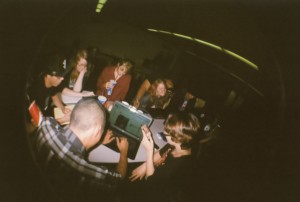
Perhaps surprisingly, now seems like the most inspiring time to be a female gamer. Currently in tournaments, the female minority statistically outperform their male counterparts, and every year the MTG community sees more female players ascend to the “Top 8” in professional tournaments (the top eight are like the finalists). According to Star City Games author Jackie Lee, who also happens to be the only woman ranked in the 100 best players worldwide, there have been four Top 8ers in the past six months; keep in mind the participants number as many as 1,200 at some of these events. However, as Lee points out, “a handful of GP Top 8s and an estimation on the number of women attendants does not constitute solid data. … The problem for a long time has been that the results of women competitors are so few and far between that they aren’t statistically relevant.”
Clearly this is a paramount issue in the MTG community, but is it an issue at the game table in San Diego City College’s cafeteria?
The answer appears to be no. Not only does the group at the game table and surrounding areas appear to be approximately half female, it is likely if you spend an hour with the group you will see a female player un-pocket their card deck or fold open a game board to begin a match. In the campus cafeteria, women are not just part of the audience, or spectators hanging on the arms of their gamer boyfriends. There are a lot of them, and they play the game, many of them quite well, to hear one prominent member of the group tell it.
Nikkei is someone you can’t miss if you frequent the game tables, a daily fixture in and around the gamers’ corner, his personality is magnetic. Outgoing, friendly, warm, and a little loud might only begin to describe Nikkei, but he has no lack of words describing the group’s philosophy on diversity in their ranks.
“I can look around and see straight, gay, bi, female, male, gender queer people. There’s whites, Mexicans, Filipinos, Hawaiians, African-Americans, you know? There’s people of every culture and every diverse part of life that come here just to play,” Nikkei says. He goes on to address the issue of women in the game, saying that “woman are definitely not excluded, no one is excluded. If you have interest in magic, or anything we do, really. If you have interest you’re part of the group.”
So does the welcoming attitude of the City College gamers represent a shift in the culture of the game or are they an outlier?
In this group, at least, Magic is moving from a homogenized suburban hobby to an urban game with a player base as culturally and ethnically diverse as the United Nations. But is this trend universal or are the City College gamers just ahead of the times? Either way, the group that inhabits that special corner of the cafeteria is certainly unique, and not just because they have chosen to spend their available time, money and energy being immersed in the game. The people at the game table go beyond welcoming new players, they have been known to give new players decks to get started, they spend time teaching rules and strategy, they go out of their way to absorb them into this community that has been passed down from semester to semester.
A sense of community
At City College’s unofficial game table, it’s not all about the game. For the cafeteria gamers that show up day after day, often just to observe or hang out, there is a stronger force driving their interest than simply the game play itself. What beckons players like Nikkei, and Arthur — in the morning, in between classes, and, for some, even after graduation — is the game and, just as important, the talk about the game. Sitting the table, I noticed that it took less than five minutes flat before a debate began over a rule discrepancy. All the character traits we generally esteem can be found at the table: passion, focus, intensity, community.
Nikkei points out that no two players are alike in strategy and in the variety of different cards they choose to build their deck. This goes to reinforce the reasons for welcoming new players. By helping newcomers learn the rules and build a formidable deck, they set the groundwork for a future opponent that may challenge them and enhance their own gaming experience and skills.
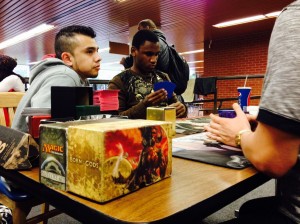
It’s not clear when this gathering of players and friends began. As the semesters come and go, so do the cast of characters around the game tables. As new members join and begin spending their free time in the cafeteria, the senior members move on. Some return, like the former student on his way home from work, to hang out, to see how the group has changed, or perhaps for some nostalgic longing to relax and talk shop in a community they feel comfortable. As the semesters pass, the novices become experts. In the same way that Native American tribes passed their oral history from generation to generation, the group passes on its teachings and, along with it, the keys to the kingdom, so to speak — the special piece of real estate in the corner of the cafeteria that holds the ever-changing and evolving group together.
And its not just Magic the Gathering that is the common cause among the group, The extended collective of players and friends includes those interested in video games, as well. It’s common for students to bring their game systems with them or use emulators on their laptops to play each other between classes. There are subgroups that are passionate about anime, they read manga and bring sketchbooks lined with hand-drawn pictures of detailed characters. Movie buffs and Marvel fans are easy to find in the group. Comic collectors and even break-dancers who show off their skills on the cafeteria floor.
Like the coffee shop in the television show “Friends” or the diner in “Seinfeld,” it is a general meeting place for this extended group of like-minded people. Once you sit down, it is easy to see how the hours can start to melt away. Throughout the day, gamers and friends stay a while and then leave, stay all day, or just pass through on their way somewhere else. But even when people stop by for only a few minutes, they still make the rounds, extending greetings to each of their friends, sometimes barreling through noisily as they blurt out a story from that morning or on the Internet the night before.
As one of Nikkei’s friends and fellow member of the group sneaks up behind him and droops her body over his chair in an awkward embrace, they both chuckle and stumble around. The scene is a flashback to high school, friends gathered around the hang out spot, giddy with excitement and relaxed laughter as they wrestle around with each other, happy and unburdened. Then Nikkei reveals a truth about this unique group of people.
“If you look around, a lot of us aren’t what society would consider normal,” he says with a chuckle. “We’re definitely on the odder side. … I feel like a lot of people come here and see that, and the fact that we’re so open with everybody, that’s what drives people to want to associate with us.”
The game corner truly is a community unto itself, with its own rules, attitude, and style. Magic is just the lynchpin. The group shares an array of interests as diverse as the members themselves. And the bond they share is strong. Even though there are several clicks and groups within the group, there is solidarity in this thing that has been passed along student to student, year after year.
“My first semester here at City I met this group and I haven’t really left,” Nikkei says. “We’re not just a group of Magic players, we’re Magic players that are also friends.”
Read more and comment at medium.com/legend-magazine


